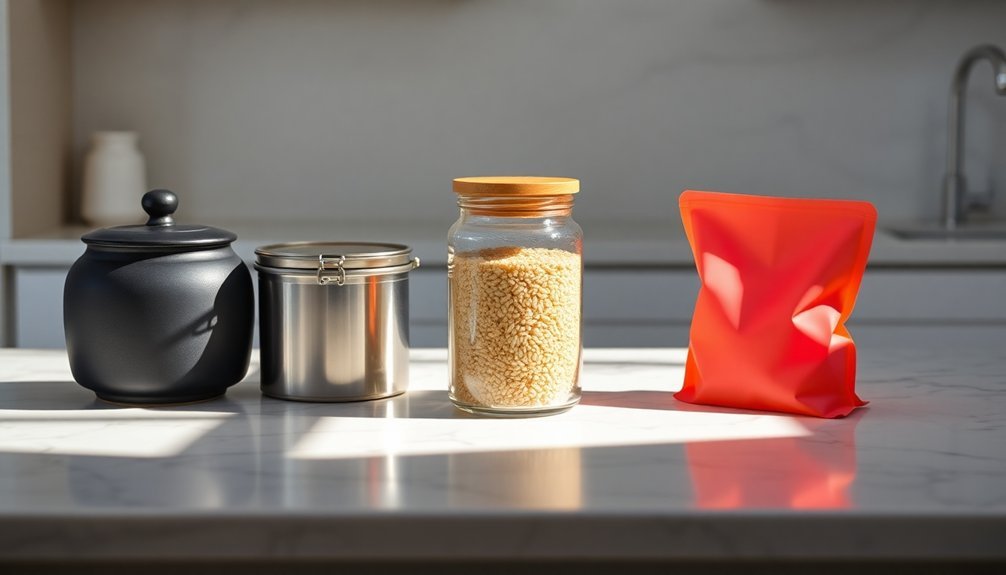To keep your rice bran fresh, store it in a cool, dark place, ideally between 50°F and 70°F. Avoid heat sources and direct sunlight. If you choose to refrigerate, keep it below 40°F, and for long-term storage, consider freezing it below 0°F. Use airtight containers to prevent moisture and odors, while monitoring humidity levels—ideally below 60%. Regularly check for signs of spoilage like rancid smells or discoloration. Following these guidelines will help maintain the quality and flavor of your rice bran. You'll find even more useful tips to keep it fresh as you explore further.
Ideal Storage Temperatures

When it comes to storing rice bran, maintaining the right temperature is vital for preserving its freshness and nutritional value. You'll want to choose storage locations that are away from heat sources like stoves and ovens. Avoid direct sunlight and areas prone to temperature fluctuations, as these can degrade the quality of your rice bran.
Instead, opt for pantries or cupboards with stable temperatures and low humidity. Using airtight containers is essential for keeping moisture, pests, and oxidation at bay. Glass jars with tight-fitting lids or food-grade plastic containers work well. For bulk storage, consider food-grade buckets with gamma seal lids. Always make sure your containers are clean and completely dry before use.
To control humidity, aim to keep relative humidity levels below 60%. This helps inhibit mold growth and prevents clumping. You might want to use desiccants or moisture-absorbing packets if necessary. Additionally, storing rice bran in a cool, dry place helps prevent oxidation and spoilage.
Regularly monitor humidity levels to maintain ideal storage conditions. If you need to extend the shelf life further, refrigeration or freezing can be effective methods. Just remember to store rice bran in airtight containers to protect it from moisture and odors.
Optimal Temperature Range
Storing rice bran at the right temperature is key to keeping it fresh and nutritious. Aim for a temperature range between 50°F and 70°F (10°C to 21°C). This consistent cooler temperature helps maintain the quality of your rice bran, avoiding excessive heat or temperature fluctuations. Suitable spots for storage include your pantry or cupboards, away from direct sunlight and heat sources. Since rice bran has a higher oil content, it is especially important to monitor its storage conditions to prevent oxidative deterioration.
To help you understand the best storage conditions, here's a quick reference table:
| Storage Method | Temperature Range | Additional Tips |
|---|---|---|
| Room Temperature | 50°F – 70°F | Keep relative humidity < 60% |
| Refrigeration | Below 40°F | Use airtight containers and label them |
| Freezing | Below 0°F | Use freezer-safe bags, remove air |
Using desiccants can also prevent moisture absorption. If you decide to refrigerate or freeze your rice bran, remember to thaw it gradually in the refrigerator to minimize moisture condensation. Following these guidelines guarantees your rice bran stays fresh and retains its nutritional value for as long as possible.
Effects of High Temperatures

High temperatures can considerably increase the risk of spoilage in rice bran, leading to quicker degradation of its nutritional content. When you store rice bran at elevated temperatures, you're not just risking quality; you're also accelerating the loss of essential nutrients. It is crucial to maintain optimal storage conditions, as RF treatment has shown to effectively inactivate lipase, preventing deterioration of rice bran. It's imperative to monitor the temperature to maintain the bran's integrity and health benefits.
Spoilage Risk Increases
At elevated temperatures, the risk of spoilage for rice bran increases dramatically. Higher temperatures accelerate chemical reactions like lipid oxidation, which can greatly degrade the quality of your rice bran. This process leads to the formation of free fatty acids (FFA), resulting in rancidity. For instance, storing rice bran at 25°C can cause FFA levels to skyrocket from 2.5% to 54.9% in just 16 weeks.
On the other hand, keeping it cool at 4-5°C maintains FFA levels around 6.9% after the same period.
Humidity often accompanies high temperatures, creating conditions ripe for mold or fungal growth. Moisture content exceeding ideal levels accelerates hydrolytic rancidity and invites microbial contamination. To combat this, make sure your rice bran is dried to around 21% moisture before storage.
Additionally, higher temperatures increase insect activity, leading to potential infestations. To minimize this risk, store rice bran in airtight, moisture-proof containers, and regularly inspect for any signs of pests.
Nutritional Degradation Accelerates
Nutritional degradation accelerates markedly when rice bran is exposed to elevated temperatures. High temperatures can inhibit lipase activity, which helps prevent rancidity. For instance, microwave heating at 850 W for just 3 minutes can considerably reduce lipase activity, offering a temporary solution.
However, processes like dry heating at 110°C for 5 minutes or steaming at 93°–104°C for 5–10 minutes can completely denature lipase, compromising the nutritional value of the bran.
Additionally, tocopherols, essential antioxidants in rice bran, degrade rapidly at high temperatures. Heating rice bran oil at 180°C leads to a complete loss of α-tocopherol after 240 hours. Even at 100°C, you'll see a 28.65% reduction in tocopherols after 432 hours, emphasizing the importance of lower storage temperatures to preserve these crucial nutrients.
While some heating methods can increase beneficial compounds like phenolics and flavonoids, they can also degrade sensitive proteins like rice bran albumin.
To maintain nutritional integrity, store rice bran at cooler temperatures (4-5°C) and consider vacuum-sealed packaging to minimize oxidative damage, ensuring you keep your rice bran fresh and nutrient-rich longer.
Importance of Temperature Stability
Temperature stability is crucial for preserving the quality and shelf life of rice bran. Maintaining the right temperature prevents the activation of lipase enzymes, which can lead to hydrolytic rancidity. For instance, heating rice bran to temperatures above 100°C effectively inactivates these enzymes, halting the increase in free fatty acid (FFA) levels that can reach alarming rates if left unstabilized.
By using methods like infrared or microwave heating, you can keep FFA levels under 4% for over four weeks, greatly enhancing the bran's storage stability.
Moreover, storing rice bran at cooler temperatures, around 4-5°C, slows down lipid degradation and helps maintain its nutritional value. This temperature control also prevents off-flavors and guarantees that crucial bioactive compounds, such as γ-oryzanol and vitamin E, remain intact.
In short, effective stabilization through proper temperature management not only extends the shelf life of rice bran but also preserves its oil quality and functional properties. By prioritizing temperature stability, you can enjoy high-quality rice bran for a longer period without sacrificing its nutritional benefits.
Relative Humidity Control

Controlling relative humidity is essential for preserving the quality of your rice bran.
Ideally, you should aim for humidity levels below 75% to prevent moisture absorption that can lead to spoilage and rancidity.
Ideal Humidity Levels
Maintaining the ideal humidity levels for rice bran storage is essential to ensuring its quality. The best relative humidity for storing rice bran is between 50-60%. Keeping humidity within this range helps prevent moisture-related issues like mold and brittleness. If humidity dips below 50%, the bran can become dry and brittle. On the other hand, humidity above 60% increases the risk of mold and fungal growth, especially when it reaches 62% or higher.
To make it easier for you to understand the impact of humidity on rice bran, here's a quick reference table:
| Humidity Range | Effects on Rice Bran | Recommended Action |
|---|---|---|
| Below 50% | Dryness and brittleness | Monitor and increase humidity |
| 50% – 60% | Best storage conditions | Maintain levels |
| Above 60% | Mold and fungal growth | Decrease humidity immediately |
Moisture Absorption Solutions
Effective moisture absorption solutions are indispensable for preserving the quality of rice bran during storage. High temperatures and elevated relative humidity can lead to moisture absorption, causing deterioration. To tackle this, you can employ several techniques to maintain ideal conditions.
- Keep your rice bran safe from spoilage.
- Ensure it retains its nutritional value.
- Avoid the loss of flavor and texture.
One effective method is microwave heating, which reduces free fatty acid content and stabilizes the bran. You can also use infrared radiation to decrease moisture and inhibit lipase activity.
Alternatively, dry heating at 120°C for 10-60 minutes can inactivate lipase, further preserving your rice bran.
Monitoring is crucial too; measure moisture content by drying the sample in an air-forced draft oven. Regularly checking water absorption capacity through centrifugation helps you understand how well your rice bran is holding up.
Managing Moisture Levels
Moisture levels play an essential role in the storage stability of rice bran. To maintain low free fatty acid (FFA) levels, you should aim for a moisture content of around 5-7% after extrusion and cooling.
If you start with raw rice bran containing 21% moisture, it can hinder the effectiveness of microwave heating and increase the risk of hydrolytic rancidity. Adjusting moisture to 20% before extrusion can help stabilize the rice bran, but remember that higher moisture levels, such as 21%, will only accelerate rancidity.
Humidity also plays a critical part in moisture management. Storing rice bran at 70% relative humidity (RH) is preferable, as it helps keep FFA levels lower compared to 78% RH. High humidity speeds up rancidity, so make an effort to keep your storage environment dry.
Additionally, using thermal treatments like extrusion at 130°C can reduce moisture and deactivate lipase enzymes, which enhances storage stability. Infrared heating or dry heat stabilization methods can also lower moisture levels effectively.
Recommended Container Types

When it comes to storing rice bran, choosing the right container is essential.
Airtight glass jars, food-grade plastic containers, and vacuum-sealed bags are all excellent options that help keep your rice bran fresh.
Each type has its advantages, so let's explore which one might work best for your needs.
Airtight Glass Jars
For storing rice bran, airtight glass jars are an excellent choice due to their durability and ability to maintain freshness.
These jars, especially those made of high-quality borosilicate glass, resist heat and guarantee that your rice bran stays safe from moisture and air. Choose transparent jars to easily monitor your contents, but remember to keep them in a dark place to avoid light exposure.
When selecting your jars, opt for those with tight-fitting lids, and consider larger capacities—like 5L or 7.5L—for bulk storage.
Specialized bamboo lids can offer extra seal integrity, making them a perfect option for long-term use.
- Enjoy peace of mind knowing your rice bran is protected.
- Feel confident in serving fresh, nutritious meals.
- Embrace the satisfaction of being organized and prepared.
Store your jars in a cool, dry place with temperatures between 50°F to 70°F (10°C to 21°C) and maintain low humidity to prevent spoilage.
With the right airtight glass jars, you'll keep your rice bran fresh and ready for your culinary creations!
Food-Grade Plastic Containers
While airtight glass jars provide excellent storage options, food-grade plastic containers can also be a practical choice for keeping your rice bran fresh. When selecting a container, make certain it's marked with numbers 1, 2, 4, or 5 to guarantee safety. Avoid those with numbers 3, 6, or 7, as they can leach harmful chemicals. Opt for BPA-free plastic and choose durable, shatter-resistant options. Thick, opaque plastic is ideal for protecting your rice bran from light and heat.
It's essential to have a tight-fitting lid to keep moisture out, as airtight containers help maintain freshness. Some containers feature a double-locking system for added security. After scooping out rice bran, seal the container immediately to keep it dry.
Store the container in a cool, dry place, ideally below 20°C (68°F), to prevent mold and pests. Avoid heat sources and direct sunlight, and keep the area clean.
For long-term storage, you might consider using oxygen absorbers and marking the purchase date on the container. A well-chosen food-grade plastic container can effectively keep your rice bran fresh and ready for use.
Vacuum-Sealed Bags
Vacuum-sealed bags are an excellent option for storing rice bran, offering a simple yet effective way to extend its shelf life. By removing air, these bags help prevent oxidation and maintain freshness.
When using vacuum-sealed bags, aim for ideal storage temperatures between 50°F to 70°F (10°C to 21°C) to keep your rice bran in top shape. If you can, refrigerate or freeze it to further enhance its longevity.
Here are a few benefits of using vacuum-sealed bags:
- Freshness: Enjoy the rich, nutty flavor of rice bran for months.
- Convenience: Store in smaller portions for easy access and reduced waste.
- Protection: Shield your rice bran from moisture and spoilage.
To maximize the effectiveness of vacuum-sealing, confirm your bags are clean and dry before filling.
Consider using freezer-safe options if you're planning to freeze. Regularly check for signs of spoilage and label your bags with storage dates to track freshness.
With these tips, you can savor the benefits of rice bran without worrying about its shelf life!
Benefits of Airtight Storage
When it comes to storing rice bran, airtight storage offers considerable advantages that can enhance its longevity and quality. By using airtight containers, you can prevent infestations, preserve the sensory quality, control oxidation, and extend shelf life.
| Benefit | Details |
|---|---|
| Prevention of Infestation | Airtight conditions inhibit insect growth and reduce the need for pest control. |
| Preservation of Quality | Maintains flavor, texture, and nutritional value over 180 days. |
| Control of Oxidation | Lower oxygen levels slow oxidation and reduce rancidity risks. |
Airtight storage guarantees that rice bran remains insect-free and minimizes spoilage caused by air and moisture. Additionally, reducing oxygen concentrations helps preserve freshness and flavor. High-quality containers made of glass, metal, or plastic can greatly extend shelf life, especially when stored in a cool, dry place.
Vacuum-sealed containers work particularly well for maintaining freshness over longer periods. By properly labeling and monitoring your stock, you can enjoy the benefits of rice bran while guaranteeing it stays fresh for your culinary needs.
Refrigeration Techniques

Refrigeration is a key strategy for preserving the freshness of rice bran, especially if you want to extend its shelf life considerably. Ideally, you should store rice bran at temperatures below 3°C to inhibit lipase activity, which can cause rancidity.
If that's not possible, keep it at 4°C, as this is still effective for reducing free fatty acids and maintaining quality. Remember, temperatures between 10°C and 21°C can be used, but they won't provide the same level of preservation.
To guarantee maximum freshness, consider these tips:
- Keep humidity below 60% to prevent mold and clumping.
- Use airtight containers to protect against moisture and odor transfer.
- Regularly check for spoilage, assuring your rice bran stays in top condition.
Advantages of Freezing
Freezing rice bran offers noteworthy advantages, especially when it comes to extending its shelf life and preserving quality. By storing it in the freezer, you can extend its usability for up to a year, effectively preventing spoilage while maintaining its nutritional value. The cold environment protects against moisture, pests, and oxidation, ensuring your rice bran remains fresh and ready for use.
One key benefit is the prevention of oxidation. Freezing removes air, considerably reducing the risk of freezer burn. If you vacuum-seal your rice bran before freezing, you'll enhance this protection even further. The low temperature slows down the degradation process, keeping unsaturated fats and antioxidants intact.
For easy storage and handling, use freezer-safe bags or containers, and don't forget to label them with the date. This allows for convenient access and bulk storage.
When you need to use your frozen rice bran, simply thaw it in the refrigerator to minimize moisture condensation.
Lastly, freezing doesn't compromise the versatility of rice bran. You can thaw it as needed for various recipes, ensuring that its nutritional profile remains intact, making it an excellent choice for baking and cooking.
Light Exposure Considerations

Protecting rice bran from light exposure is essential for maintaining its freshness and quality. When rice bran is exposed to light, it accelerates degradation and can lead to oxidation, which decreases its overall quality. To keep your rice bran at its best, you should store it in a cool, dark place, away from direct sunlight.
Here are some key points to remember:
- Light exposure can create off-flavors and rancidity, ruining the taste you love.
- Fresh rice bran not only tastes better but also retains its nutritional benefits.
- You deserve to enjoy the full flavor and health advantages of your rice bran.
Choose storage containers made of glass or dark-colored plastic to shield it from light. Airtight containers will also help prevent air from reaching the bran, keeping it fresh longer.
Avoid placing your rice bran near stoves or windows; instead, opt for a pantry or cupboard that remains consistently dark. If you want to go the extra mile, consider vacuum-sealing smaller portions, which can provide even more protection against light exposure.
Signs of Spoilage
Identifying signs of spoilage in rice bran is essential for ensuring its quality and safety. Start by checking the odor; if you notice a rancid or off-putting smell, that's a clear sign of degradation. Fresh rice bran should have a mild, nutty scent, while spoiled bran might emit sour or musty odors.
Next, look for visual cues. Discoloration is a major indicator; if the bran's color has darkened from light brown, it's likely spoiled. Mold growth, which appears as fuzzy spots in green, white, or black, is another alarming sign. Additionally, you should watch for clumping or any oily residue.
Texture changes can also signal spoilage. Fresh rice bran should feel dry and slightly coarse, while spoiled bran may become clumpy or develop hard lumps. Excess moisture is an indicator of degradation.
Finally, be aware of other spoilage signs. If you taste the bran and find it bitter or rancid, it's time to discard it. Mold, unusual off-flavors, or pest infestation are significant red flags that tell you the bran is no longer safe to use.
Always trust your senses when evaluating rice bran's freshness.
Frequently Asked Questions
Can I Store Rice Bran in the Pantry?
You shouldn't store rice bran in the pantry. It's often too warm and humid, leading to rancidity. Instead, opt for cooler, controlled environments like a refrigerator or freezer to maintain its freshness longer.
How Often Should I Check Stored Rice Bran?
You should check your stored rice bran every 2-3 months if it's at room temperature. For refrigerated rice bran, inspect it every 4-6 months, ensuring it stays fresh and free from spoilage.
Is It Safe to Use Rice Bran Past Its Storage Date?
Yes, it's generally safe to use rice bran past its storage date if you don't see any signs of spoilage. Always check for changes in smell, color, or texture before using it.
What Pests Should I Watch for in Rice Bran?
You should watch for rice weevils, moths, and beetles in rice bran. Rodents can also be a concern if containers aren't sealed properly. Regular inspections help you catch infestations early before they escalate.
Can I Mix Rice Bran With Other Grains for Storage?
Yes, you can mix rice bran with other grains, but be cautious. The differing moisture and lipid contents might lead to uneven spoilage. Store them properly to maintain freshness and extend shelf life.
In Summary
To keep your rice bran fresh, always store it at the ideal temperature, ideally between 40°F and 70°F. Avoid high temperatures that can spoil its nutrients and flavor. Maintain stable conditions and monitor humidity levels to prevent moisture-related issues. If you need to extend its shelf life, consider refrigeration or even freezing. Finally, protect it from light exposure, and watch for signs of spoilage. By following these tips, you'll enjoy fresh rice bran for longer!





Leave a Reply